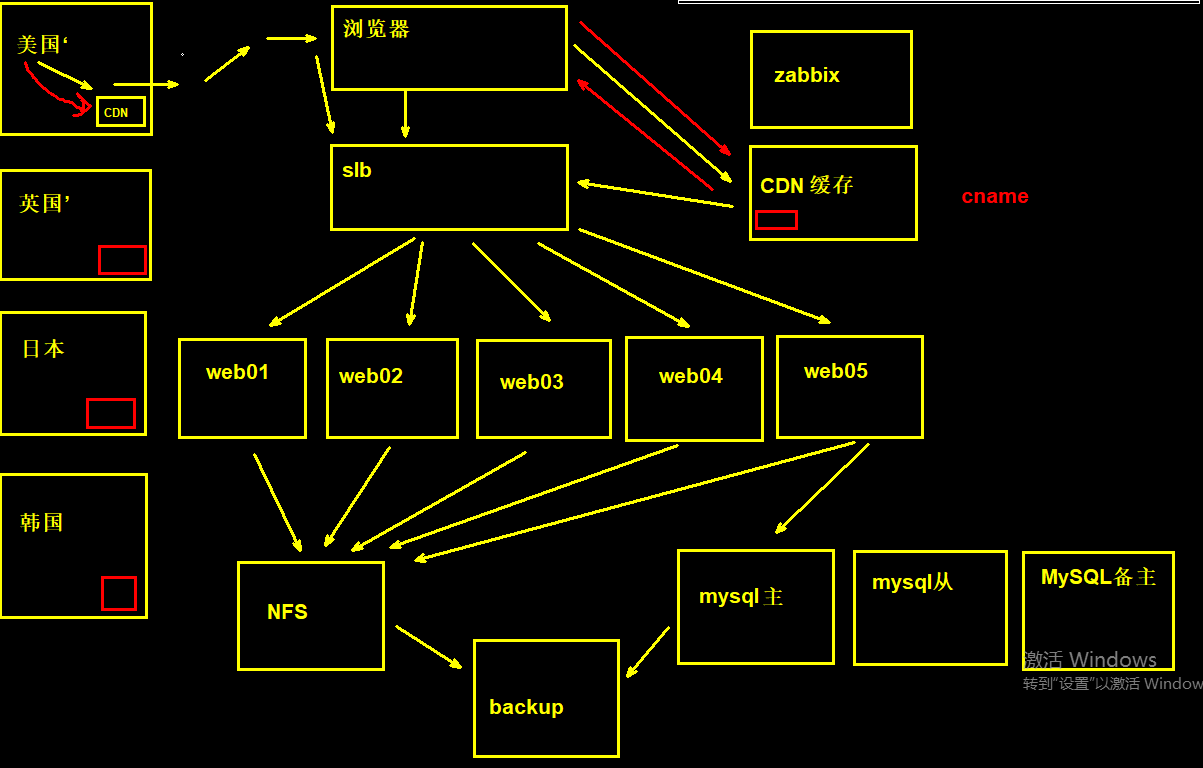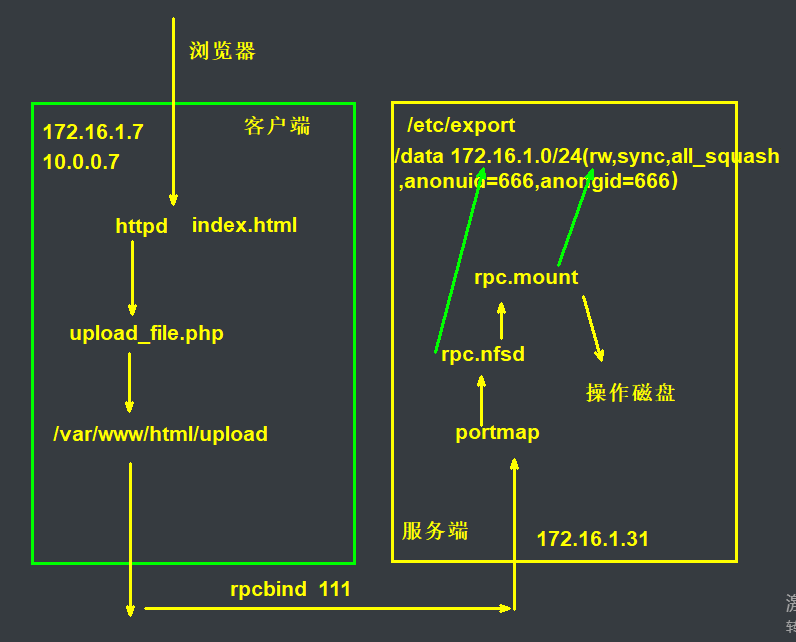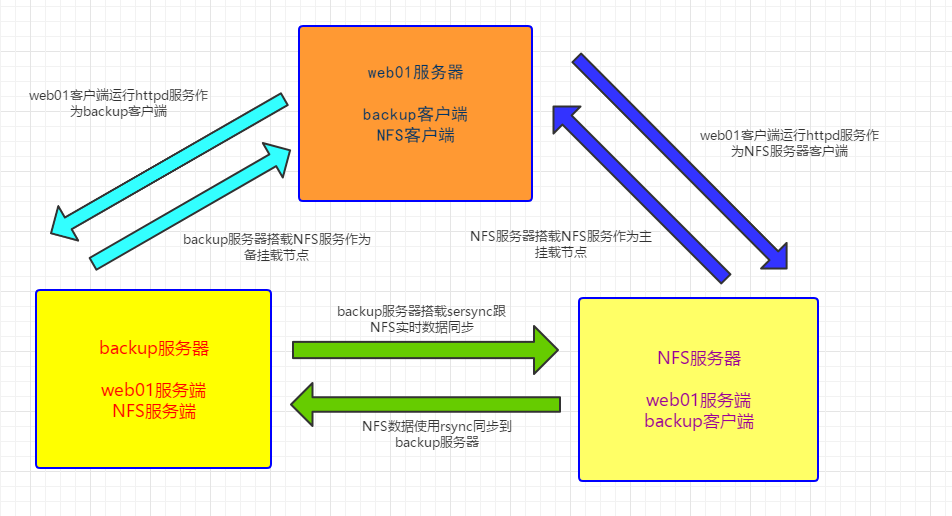第五章 NFS、rsync等统一用户相关操作
一、统一用户
1.httpd
2.NFS挂载目录
3.rsync
1.所有服务器统一创建用户
[root@web01 ~]# groupadd www -g 666
[root@web01 ~]# useradd www -u 666 -g 666
2.修改httpd用户
[root@web01 ~]# vim /etc/httpd/conf/httpd.conf
User www
Group www
#重启服务
[root@web01 ~]# systemctl restart httpd
[root@web01 ~]# ps -ef | grep httpd
root 31537 1 1 21:57 ? 00:00:00 /usr/sbin/httpd -DFOREGROUND
www 31538 31537 0 21:57 ? 00:00:00 /usr/sbin/httpd -DFOREGROUND
www 31539 31537 0 21:57 ? 00:00:00 /usr/sbin/httpd -DFOREGROUND
www 31540 31537 0 21:57 ? 00:00:00 /usr/sbin/httpd -DFOREGROUND
www 31541 31537 0 21:57 ? 00:00:00 /usr/sbin/httpd -DFOREGROUND
www 31542 31537 0 21:57 ? 00:00:00 /usr/sbin/httpd -DFOREGROUND
root 31544 18601 0 21:57 pts/1 00:00:00 grep --color=auto httpd
3.修改NFS服务端权限
[root@NFS /data]# vim /etc/exports
/data 172.16.1.0/24(rw,sync,all_squash,anonuid=666,anongid=666)
#重启
[root@NFS /data]# systemctl restart NFS
4.修改rsync用户
[root@backup ~]#vim /etc/rsyncd.conf
uid = www
gid = www
port = 873
fake super = yes
use chroot = no
max connections = 200
timeout = 600
ignore errors
read only = false
list = false
auth users = rsync_backup
secrets file = /etc/rsync.passwd
log file = /var/log/rsyncd.log
#####################################
[backup]
comment = welcome to oldboyedu backup!
path = /backup
5.NFS服务端重新授权目录
[root@NFS ~]# chown -R www.www /data/
6.web端重新挂载
[root@web01 /var/www/html]# umount /var/www/html/upload
[root@web01 /var/www/html]# mount -t NFS 172.16.1.31:/data ./upload
7.rsync服务端重新授权目录
[root@backup ~]#chown -R www:www /backup
二、NFS总结
1.NFS储存优点
1)简单易用,部署方便
2)数据可查,服务稳定
2.NFS的服务缺点
1)存在单点故障, 如果构建高可用维护麻烦web->NFS()->backup
2)NFS数据明文, 并不对数据做任何校验。
3)客户端挂载NFS服务没有密码验证, 安全性一般(内网使用)
3.NFS应用建议
1)开机挂载
如果希望NFS文件共享服务能一直有效,则需要将其写入到fstab文件中
#编辑fstab文件
[root@NFS-client ~]# vim /etc/fstab
172.16.1.31:/data /NFSdir NFS defaults 0 0
#验证fstab是否写正确
[root@NFS-client ~]# mount -a
2)生产场景应将静态数据尽可能往前端推,减少后端存储压力
3)必须将存储里的静态资源通过CDN缓存,jpg\png\mp4\avi\css\js
4)如果没有缓存或架构本身历史遗留问题太大, 在多存储也无用

三、rsync+NFS解决单点故障
1.环境准备
|
主机 |
角色 | IP |
|---|---|---|
| backup | rsync服务端,NFS服务端 | 172.16.1.41 |
| NFS | rsync客户端,NFS服务端 | 172.16.1.31 |
| web01 | rsync客户端,NFS客户端 | 172.16.1.7,10.0.0.7 |
2.web01搭载上传作业平台
1.安装httpd和php
[root@web01 ~]# yum install -y httpd php
2.上传代码
[root@web01 ~]# rz kaoshi.zip
[root@web01 ~]# yum unzip
[root@web01 ~]# unzip kaoshi.zip -d /var/www/html/
3.创建httpd用户
[root@web01 ~]# groupadd www -g 666
[root@web01 ~]# useradd www -u 666 -g 666
4.配置httpd服务
[root@web01 ~]# vim /etc/httpd/conf/httpd.conf
User www
Group www
#开启服务
[root@web01 ~]# systemctl start httpd
5.修改权限
[root@web01 ~]# chown -R www.www /var/www/html/
3.NFS服务器搭建NFS服务端
1.安装NFS
[root@NFS ~]# yum install -y NFS-utils rpcbind
2.配置NFS
[root@backup ~]# vim /etc/exports
/data 172.16.1.0/24(rw,sync,all_squash,anonuid=666,anongid=666)
3.查看配置生效
[root@backup ~]# cat /var/lib/nfs/etab
/data 172.16.1.0/24(rw,sync,wdelay,hide,nocrossmnt,secure,root_squash,all_squash,no_subtree_check,secure_locks,acl,no_pnfs,anonuid=666,anongid=666,sec=sys,rw,secure,root_squash,all_squash)
4.创建用户
[root@web01 ~]# groupadd www -g 666
[root@web01 ~]# useradd www -u 666 -g 666
5.创建目录
[root@web01 ~]# mkdir /data
[root@web01 ~]# chown -R www.www /data
4.挂载web01数据目录
[root@web01 ~]# showmount -e 172.16.1.31
[root@web01 ~]# mount -t nfs 172.16.1.31:/data /var/www/html/upload
5.backup搭建rsync服务端
1.安装rsync
[root@backup ~]# yum -y install rsyncd
2.配置rsync
[root@backup ~]# cat /etc/rsyncd.conf
uid = www
gid = www
port = 873
fake super = yes
use chroot = no
max connections = 200
timeout = 600
ignore errors
read only = false
list = true
auth users = rsync_backup
secrets file = /etc/rsync.passwd
log file = /var/log/rsyncd.log
#####################################
[backup]
comment = "文件备份目录"
path = /backup
[data]
comment = "数据备份目录"
path = /data
3.重启rsync
[root@backup ~]# systemctl restart rsyncd
6.NFS数据实时备份到backup服务器
1.安装inotify
[root@nfs ~]# yum -y install inotify-tools
2.编写脚本实时备份data目录
[root@nfs /data]# vim /scripts/backup_data.sh
#!/bin/bash
dir=/data
export RSYNC_PASSWORD=123456
/usr/bin/inotifywait -mrq --format '%w %f' -e create,delete,attrib,close_write $dir | while read line;do
cd $dir && rsync -az -R --delete . rsync_backup@172.16.1.41::data >/dev/null 2>&1
done &
3.启动脚本
[root@nfs /data]# sh /scripts/backup_data.sh
7.测试
1.访问交作业页面,上传图片
2.查看web服务器
[root@web01 ~]# ll /var/www/html/upload
3.查看nfs服务器data目录
[root@nfs ~]# ll /data/
4.查看backup服务器data目录
[root@backup ~]# ll /data
8.backup搭建NFS服务端
1.安装NFS
[root@backup ~]# yum install -y nfs-utils rpcbind
2.配种NFS
[root@backup ~]# vim /etc/exports
/data 172.16.1.0/24(rw,sync,all_squash,anonuid=666,anongid=666)
3.创建用户
[root@backup ~]# groupadd www -g 666
[root@backup ~]# useradd www -u 666 -g 666
4.启动服务
[root@backup ~]# systemctl start nfs
9.测试
1.NFS服务器出现故障
[root@nfs ~]# systemctl stop nfs
2.切换挂载机器
[root@web01 ~]# umount -lf /var/www/html/upload
[root@web01 ~]# mount -t nfs 172.16.1.41:/data /var/www/html/upload
四、实时同步
1.实时同步简单介绍
1.概述
实时同步是一种只要当前目录发生变化则会触发一个事件,事件触发后会将变化的目录同步至远程服务器
2.为什么要实时同步
保证数据的连续性, 减少人力维护成本,解决nfs单点故障
3.实时同步数据选择
sersync+RSYNC(√)、inotify+rsync
Inotify是一个通知接口,用来监控文件系统的各种变化,如果文件存取,删除,移动。可以非常方便地实现文件异动告警,增量备份,并针对目录或文件的变化及时作出响应。rsync+inotify可以实触发式实时同步增量备份
sersync是国人基于rsync+inotify-tools开发的工具,不仅保留了优点同时还强化了实时监控,文件过滤,简化配置等功能,帮助用户提高运行效率,节省时间和网络资源。
2.安装sersync(NFS服务器)
1.安装sersync和inotify
[root@nfs01 ~]# yum install rsync inotify-tools -y
2.下载serdync软件包
[root@nfs01 ~]# wget https://raw.githubusercontent.com/wsgzao/sersync/master/sersync2.5.4_64bit_binary_stable_final.tar.gz
3.解压安装包
[root@nfs ~]# tar xf sersync2.5.4_64bit_binary_stable_final.tar.gz
4.移动并改名
[root@nfs ~]# mv GNU-Linux-x86 /usr/local/sersync
5.修改配置文件
[root@nfs ~]# cat /usr/local/sersync/confxml.xml
<?xml version="1.0" encoding="ISO-8859-1"?>
<head version="2.5">
#主机IP
<host hostip="localhost" port="8008"></host>
#调试模式
<debug start="false"/>
<fileSystem xfs="false"/>
#文件过滤
<filter start="false">
<exclude expression="(.*)\.svn"></exclude>
<exclude expression="(.*)\.gz"></exclude>
<exclude expression="^info/*"></exclude>
<exclude expression="^static/*"></exclude>
</filter>
#inotify监控配置
<inotify>
#inotify监控的行为
<delete start="true"/>
<createFolder start="true"/>
<createFile start="true"/>
<closeWrite start="true"/>
<moveFrom start="true"/>
<moveTo start="true"/>
<attrib start="true"/>
<modify start="true"/>
</inotify>
#推送部分
<sersync>
#本地监控的目录
<localpath watch="/data">
#远程IP及模块名字
<remote ip="172.16.1.41" name="data"/>
</localpath>
<rsync>
#rsync同步时的参数
<commonParams params="-artuz"/>
#开启认证
<auth start="true" users="rsync_backup" passwordfile="/etc/rsync.password"/>
#如果rsync服务不是873端口,需要开启
<userDefinedPort start="false" port="874"/><!-- port=874 -->
#超时时间
<timeout start="false" time="100"/><!-- timeout=100 -->
<ssh start="false"/>
</rsync>
#指定错误日志
<failLog path="/tmp/rsync_fail_log.sh" timeToExecute="60"/><!--default every 60mins execute once-->
#定时任务,默认600分钟进行一次全备
<crontab start="false" schedule="600"><!--600mins-->
#定时任务文件过滤
<crontabfilter start="false">
<exclude expression="*.php"></exclude>
<exclude expression="info/*"></exclude>
</crontabfilter>
</crontab>
<plugin start="false" name="command"/>
</sersync>
<plugin name="command">
<param prefix="/bin/sh" suffix="" ignoreError="true"/> <!--prefix /opt/tongbu/mmm.sh suffix-->
<filter start="false">
<include expression="(.*)\.php"/>
<include expression="(.*)\.sh"/>
</filter>
</plugin>
<plugin name="socket">
<localpath watch="/opt/tongbu">
<deshost ip="192.168.138.20" port="8009"/>
</localpath>
</plugin>
<plugin name="refreshCDN">
<localpath watch="/data0/htdocs/cms.xoyo.com/site/">
<cdninfo domainname="ccms.chinacache.com" port="80" username="xxxx" passwd="xxxx"/>
<sendurl base="http://pic.xoyo.com/cms"/>
<regexurl regex="false" match="cms.xoyo.com/site([/a-zA-Z0-9]*).xoyo.com/images"/>
</localpath>
</plugin>
</head>
[root@nfs ~]#
6.创建密码文件
[root@nfs ~]# echo 123456 > /etc/rsync.password
[root@nfs ~]# chmod 600 /etc/rsync.password
7.启动
#查看参数
[root@nfs ~]# /usr/local/sersync/sersync2 -h
set the system param
execute:echo 50000000 > /proc/sys/fs/inotify/max_user_watches
execute:echo 327679 > /proc/sys/fs/inotify/max_queued_events
parse the command param
_______________________________________________________
参数-d:启用守护进程模式
参数-r:在监控前,将监控目录与远程主机用rsync命令推送一遍
c参数-n: 指定开启守护线程的数量,默认为10个
参数-o:指定配置文件,默认使用confxml.xml文件
参数-m:单独启用其他模块,使用 -m refreshCDN 开启刷新CDN模块
参数-m:单独启用其他模块,使用 -m socket 开启socket模块
参数-m:单独启用其他模块,使用 -m http 开启http模块
不加-m参数,则默认执行同步程序
[root@nfs ~]# /usr/local/sersync/sersync2 -dro /usr/local/sersync/confxml.xml
set the system param
execute:echo 50000000 > /proc/sys/fs/inotify/max_user_watches
execute:echo 327679 > /proc/sys/fs/inotify/max_queued_events
parse the command param
option: -d run as a daemon
option: -r rsync all the local files to the remote servers before the sersync work
option: -o config xml name: /usr/local/sersync/confxml.xml
daemon thread num: 10
parse xml config file
host ip : localhost host port: 8008
will ignore the inotify createFile event
daemon start,sersync run behind the console
use rsync password-file :
user is rsync_backup
passwordfile is /etc/rsync.password
config xml parse success
please set /etc/rsyncd.conf max connections=0 Manually
sersync working thread 12 = 1(primary thread) + 1(fail retry thread) + 10(daemon sub threads)
Max threads numbers is: 22 = 12(Thread pool nums) + 10(Sub threads)
please according your cpu ,use -n param to adjust the cpu rate
------------------------------------------
rsync the directory recursivly to the remote servers once
working please wait...
execute command: cd /data && rsync -artuz -R --delete ./ rsync_backup@172.16.1.41::data --password-file=/etc/rsync.password >/dev/null 2>&1
run the sersync:
watch path is: /data
五、作业:sersync+NFS实战
1.需求
1.恢复快照
2.搭建交作业系统
3.配置挂载数据目录
4.NFS的数据目录实时备份到backup服务器(要求使用sersync)
2.环境准备
| 主机 | 角色 | IP |
|---|---|---|
| backup | rsync服务端,NFS服务端 | 172.16.1.41 |
| NFS | rsync客户端,NFS服务端 | 172.16.1.31 |
| web01 | rsync客户端,NFS客户端 | 172.16.1.7,10.0.0.7 |
3.web01搭载上传作业平台
1.关闭防火墙
[root@web01 ~]# systemctl stop firewalld
[root@web01 ~]# systemctl disable firewalld
2.关闭selinux
[root@web01 ~]# setenforce 0
[root@web01 ~]# vim /etc/selinux/config
SELINUX=disabled
3.安装httpd和php
[root@web01 ~]# yum -y install httpd php
4.上传作业平台代码并解压到指定目录
[root@web01 ~]# rz -bye
[root@web01 ~]# ll
total 36
-rw-------. 1 root root 1350 Jun 9 21:42 anaconda-ks.cfg
-rw-r--r--. 1 root root 497 Aug 5 16:53 hostname_ip.sh
-rw-r--r-- 1 root root 26995 Aug 13 16:42 kaoshi.zip
[root@web01 ~]# unzip kaoshi.zip -d /var/www/html/
Archive: kaoshi.zip
inflating: /var/www/html/info.php
inflating: /var/www/html/bg.jpg
inflating: /var/www/html/index.html
inflating: /var/www/html/upload_file.php
5.修改httpd配置
[root@web01 ~]# vim /etc/httpd/conf/httpd.conf
User www
Group www
6.创建统一用户
[root@web01 ~]# groupadd -g 666 www
[root@web01 ~]# useradd -u 666 -g 666 www
7.修改用户权限
[root@web01 ~]# chown -R www:www /var/www/html/
8.重启服务并验证服务
[root@web01 ~]# systemctl restart httpd
[root@web01 ~]# ps aux |grep http
root 24063 0.8 0.5 314580 12128 ? Ss 19:49 0:00 /usr/sbin/httpd -DFOREGROUND
www 24064 0.0 0.3 314712 6160 ? S 19:49 0:00 /usr/sbin/httpd -DFOREGROUND
www 24065 0.0 0.3 314712 6160 ? S 19:49 0:00 /usr/sbin/httpd -DFOREGROUND
www 24066 0.0 0.3 314712 6160 ? S 19:49 0:00 /usr/sbin/httpd -DFOREGROUND
www 24067 0.0 0.3 314712 6160 ? S 19:49 0:00 /usr/sbin/httpd -DFOREGROUND
www 24068 0.0 0.3 314712 6160 ? S 19:49 0:00 /usr/sbin/httpd -DFOREGROUND
root 24070 0.0 0.0 112708 976 pts/0 R+ 19:49 0:00 grep --color=auto http
4.NFS服务器搭建NFS服务端
1.关闭防火墙
[root@nfs ~]# systemctl stop firewalld
[root@nfs ~]# systemctl disable firewalld
2.关闭selinux
[root@NFS ~]# setenforce 0
[root@NFS ~]# vim /etc/selinux/config
SELINUX=disabled
3.安装nfs和rpcbind
[root@nfs ~]# yum -y install nfs-utils rpcbind
4.配置nfs服务
[root@nfs ~]# vim /etc/exports
/web/data 172.16.1.0/24(rw,sync,all_squash,anonuid=666,anongid=666)
5.重启服务并验证
[root@nfs ~]# systemctl restart nfs
[root@nfs ~]# cat /var/lib/nfs/etab
/web/data 172.16.1.0/24(rw,sync,wdelay,hide,nocrossmnt,secure,root_squash,all_squash,no_subtree_check,secure_locks,acl,no_pnfs,anonuid=666,anongid=666,sec=sys,rw,secure,root_squash,all_squash)
6.创建统一用户
[root@nfs ~]# groupadd -g 666 www
[root@nfs ~]# useradd -u 666 -g 666 www
7.创建挂载目录并修改权限
[root@nfs ~]# mkdir -p /web/data
[root@nfs ~]# chown -R www:www /web/data/
5.web01客户端挂载目录
1.安装nfs和rpcbind
[root@web01 ~]# yum -y install nfs rpcbind
2.启动rpcbind
[root@web01 ~]# systemctl start rpcbind
3.查看挂载点
[root@web01 ~]# showmount -e 172.16.1.31
Export list for 172.16.1.31:
/web/data 172.16.1.0/24
4.挂载目录
[root@web01 ~]# mount -t nfs 172.16.1.31:/web/data /var/www/html/upload
5.查看挂载点
[root@web01 ~]# df -h
Filesystem Size Used Avail Use% Mounted on
/dev/sda3 98G 1.7G 96G 2% /
devtmpfs 980M 0 980M 0% /dev
tmpfs 991M 0 991M 0% /dev/shm
tmpfs 991M 9.6M 981M 1% /run
tmpfs 991M 0 991M 0% /sys/fs/cgroup
/dev/sda1 497M 120M 378M 25% /boot
tmpfs 199M 0 199M 0% /run/user/0
172.16.1.31:/web/data 98G 1.7G 96G 2% /var/www/html/upload
6.backup搭建rsync服务端
1.关闭防火墙
[root@backup ~]# systemctl stop firewalld
[root@backup ~]# systemctl disable firewalld
2.关闭selinux
[root@backup ~]# setenforce 0
[root@backup ~]# vim /etc/selinux/config
SELINUX=disabled
3.安装rsync服务
[root@backup ~]# yum -y install rsync
4.配置rsync服务
[root@backup ~]# vim /etc/rsyncd.conf
uid = www
gid = www
port = 873
fake super = yes
use chroot = no
max connections =200
timeout = 600
ignore errors
read only =false
list = true
auth users = rsync_backup
secrets file = /etc/rsync.passwd
log file = /var/log/rsyncd.log
#####################################
[backup]
comment = "文件备份目录"
path = /backup
[data]
comment = "数据备份目录"
path = /data
5.创建统一用户
[root@backup ~]# groupadd -g 666 www
[root@backup ~]# useradd -u 666 -g 666 www
6.创建密码文件并修改权限
[root@backup ~]# echo "rsync_backup:123456" >/etc/rsync.passwd
[root@backup ~]# chmod 600 /etc/rsync.passwd
7.创建备份目录并修改权限
[root@backup ~]# mkdir /backup
[root@backup ~]# mkdir /data
[root@backup ~]# chown -R www:www /backup/
[root@backup ~]# chown -R www:www /data/
8,重启服务并验证服务
[root@backup ~]# systemctl restart rsyncd
[root@backup ~]# netstat -lntp
Active Internet connections (only servers)
Proto Recv-Q Send-Q Local Address Foreign Address State PID/Program name
tcp 0 0 0.0.0.0:873 0.0.0.0:* LISTEN 24097/rsync
tcp 0 0 0.0.0.0:111 0.0.0.0:* LISTEN 6135/rpcbind
tcp 0 0 0.0.0.0:22 0.0.0.0:* LISTEN 7151/sshd
tcp 0 0 127.0.0.1:25 0.0.0.0:* LISTEN 7291/master
tcp6 0 0 :::873 :::* LISTEN 24097/rsync
tcp6 0 0 :::111 :::* LISTEN 6135/rpcbind
tcp6 0 0 :::22 :::* LISTEN 7151/sshd
tcp6 0 0 ::1:25 :::* LISTEN 7291/master
7.NFS数据实时备份到backup服务器
1.安装inotify
[root@nfs ~]# yum install rsync inotify-tools -y
2.上传serdync软件包
[root@nfs ~]# rz -bye
[root@nfs ~]# ll
-rw-r--r-- 1 root root 727290 Aug 14 17:15 sersync2.5.4_64bit_binary_stable_final.tar.gz
3.解压安装包
[root@nfs ~]# [root@nfs ~]# tar -xf sersync2.5.4_64bit_binary_stable_final.tar.gz
4.移动并改名
[root@nfs ~]# mv GNU-Linux-x86 /usr/local/sersync
5.修改配置文件
[root@nfs ~]# vim /usr/local/sersync/confxml.xml
</crontab>
<plugin start="false" name="command"/>
</sersync>
<plugin name="command">
<param prefix="/bin/sh" suffix="" ignoreError="true"/> <!--prefix /opt/tongbu/mmm.sh suffix-->
<filter start="false">
<include expression="(.*)\.php"/>
<include expression="(.*)\.sh"/>
</filter>
</plugin>
<plugin name="socket">
<localpath watch="/opt/tongbu">
<deshost ip="192.168.138.20" port="8009"/>
</localpath>
</plugin>
<plugin name="refreshCDN">
<localpath watch="/data0/htdocs/cms.xoyo.com/site/">
<cdninfo domainname="ccms.chinacache.com" port="80" username="xxxx" passwd="xxxx"/>
<sendurl base="http://pic.xoyo.com/cms"/>
<regexurl regex="false" match="cms.xoyo.com/site([/a-zA-Z0-9]*).xoyo.com/images"/>
</localpath>
</plugin>
</head>
6.创建密码文件并设置权限
[root@nfs ~]# echo "123456" >/etc/rsync.password
[root@nfs ~]# chmod 600 /etc/rsync.password
7.启动数据实时同步
[root@nfs ~]# /usr/local/sersync/sersync2 -dro /usr/local/sersync/confxml.xml
set the system param
execute:echo 50000000 > /proc/sys/fs/inotify/max_user_watches
execute:echo 327679 > /proc/sys/fs/inotify/max_queued_events
parse the command param
option: -d run as a daemon
option: -r rsync all the local files to the remote servers before the sersync work
option: -o config xml name: /usr/local/sersync/confxml.xml
daemon thread num: 10
parse xml config file
host ip : localhost host port: 8008
will ignore the inotify createFile event
daemon start,sersync run behind the console
use rsync password-file :
user is rsync_backup
passwordfile is /etc/rsync.password
config xml parse success
please set /etc/rsyncd.conf max connections=0 Manually
sersync working thread 12 = 1(primary thread) + 1(fail retry thread) + 10(daemon sub threads)
Max threads numbers is: 22 = 12(Thread pool nums) + 10(Sub threads)
please according your cpu ,use -n param to adjust the cpu rate
------------------------------------------
rsync the directory recursivly to the remote servers once
working please wait...
execute command: cd /web/data && rsync -artuz -R --delete ./ rsync_backup@172.16.1.41::data --password-file=/etc/rsync.password >/dev/null 2>&1
run the sersync:
watch path is: /web/data
8.backup搭建NFS服务端
1.安装nfs和rpcbind
[root@backup ~]# yum -y install nfs rpcbind
2.配置nfs服务
[root@backup ~]# vim /etc/exports
/backup 172.16.1.0/24(rw,sync,all_squash,anonuid=666,anongid=666)
3.重启服务并验证
[root@backup ~]# cat /var/lib/nfs/etab
/backup 172.16.1.0/24(rw,sync,wdelay,hide,nocrossmnt,secure,root_squash,all_squash,no_subtree_check,secure_locks,acl,no_pnfs,anonuid=666,anongid=666,sec=sys,rw,secure,root_squash,all_squash)
9.测试
1.访问交作业页面,上传图片
2.查看web服务器
[[root@web01 /var/www/html/upload]# ll
total 48
-rw-r--r-- 1 www www 46257 Aug 14 21:05 1_jh.jpg
3.查看nfs服务器data目录
[root@nfs /web/data]# ll
total 48
-rw-r--r-- 1 www www 46257 Aug 14 21:05 1_jh.jpg
4.查看backup服务器data目录
[root@backup /data]# ll
total 48
-rw-r--r-- 1 www www 46257 Aug 14 21:05 1_jh.jpg
第五章 NFS、rsync等统一用户相关操作的更多相关文章
- linux常用命令---用户相关操作
用户相关操作
- NO12 useradd-passwd-uname-hostname命令-上传rz下载sz-批量部署- Linux用户相关操作
24 useradd #添加用户 语法:useradd 用户名 例子:ueradd oldboy .25 passwd #为用户设置或修改 ...
- Oracle使用——oracle用户相关操作
前提 以dba角色登录数据库(普通用户没有操作权限):sqlplus / as sysdba 具体操作 创建用户 创建用户 使用默认表空间创建用户 create user xzgxh identifi ...
- Linux网络服务第五章NFS共享服务
1.笔记 NFS一般用在局域网中,网络文件系统c/s格式 服务端s:设置一个共享目录 客户端c:挂载使用这个共享目录 rpc:111远程过程调用机制 Showmount -e:查看共享目录信息 def ...
- Mysql用户相关操作
MySQL 默认有个root用户,但是这个用户权限太大,一般只在管理数据库时候才用.如果在项目中要连接 MySQL 数据库,则建议新建一个权限较小的用户来连接. 在 MySQL 命令行模式下输入如下命 ...
- Windows用户相关操作
获取所有用户 NET_API_STATUS NetUserEnum( LPCWSTR servername, DWORD level, DWORD filter, LPBYTE* bufptr, DW ...
- Linux之用户相关操作
1. 创建用户 useradd -m wolf #即创建一个用户并且创建同名的家目录 2. 设置密码 passwd wolf
- mysql设置指定ip访问,用户权限相关操作
基础语法GRANT priv_type ON database.table TO user[IDENTIFIED BY [PASSWORD] 'password'] [,user [IDENTIFIE ...
- Gradle 1.12用户指南翻译——第四十五章. 应用程序插件
本文由CSDN博客貌似掉线翻译,其他章节的翻译请参见: http://blog.csdn.net/column/details/gradle-translation.html 翻译项目请关注Githu ...
随机推荐
- PhpStorm license server(版权许可服务器)在线激活服务器集群列表
原文链接:https://bingyishow.top/easy/55.html 服务器列表 序号 服务器(域名) 状态 1 http://www.yuanzhaoyi.cn 在线 2 http:// ...
- [LeetCode]196. 删除重复的电子邮箱(delete)
题目 编写一个 SQL 查询,来删除 Person 表中所有重复的电子邮箱,重复的邮箱里只保留 Id 最小 的那个. +----+------------------+ | Id | Email | ...
- 如何借助 IDEA 数据库管理工具可视化使用 TDengine?
什么是IDEA Database管理工具? 这里首先介绍下IDEA,IDEA全称IntelliJ IDEA,是Java语言开发的集成环境,IntelliJ在业界被公认为最好的Java开发工具之一. I ...
- Vue iview可编辑表格的实现
创建table实例页 views/table.vue <template> <h1>table page</h1> </template> <sc ...
- python3 函数的参数
函数的参数 形参(函数定义时) + 实参(函数调用时) 形参:形式参数 在函数的定义处定义的参数,比如def func(参数1, 参数2, 参数3...) 普通参数(位置参数), 默认参数,普通收集参 ...
- 我搭建了一套企业级私有Git服务,抗住了每天上万次攻击!
写在前面 事情是这样的,今年疫情期间,我在某云购买了一套服务器,做什么呢?不是用来部署项目,也不是用来搭建网站,而是用来做代码备份和管理.没错,都是我个人的代码,也许你会说,你个人能有多少代码啊?确实 ...
- 安装Windows10操作系统 - 初学者系列 - 学习者系列文章
今天无事,就将安装操作系统的几种方式进行了总结( https://www.cnblogs.com/lzhdim/p/13719725.html ).这篇博文主要是对安装windows10操作系统的过程 ...
- Centos-进程运行状态-ps
ps 显示系统进程在瞬间的运行状态 相关选项 -a 显示所有用户的进程,包含每个程序的完整路径 -x 显示所有系统程序,包括那些没有终端的程序 -u 显示使用者的名称和起始时间 -f 详细显示程序执 ...
- IOS 数据储存
IOS 数据存储 ios数据存储包括以下几种存储机制: 属性列表 对象归档 SQLite3 CoreData AppSettings 普通文件存储 1.属性列表 // // Persistence1 ...
- 【题解】[ZJOI2009]狼和羊的故事
题目戳我 \(\text{Solution:}\) 显然思路,把所有羊看成一个源点,所有狼看成一个汇点,格子之间连容量为\(1\)的边,直接跑最小割. 技巧: 注意到篱笆不能把羊给割掉,狼同理.所以, ...



